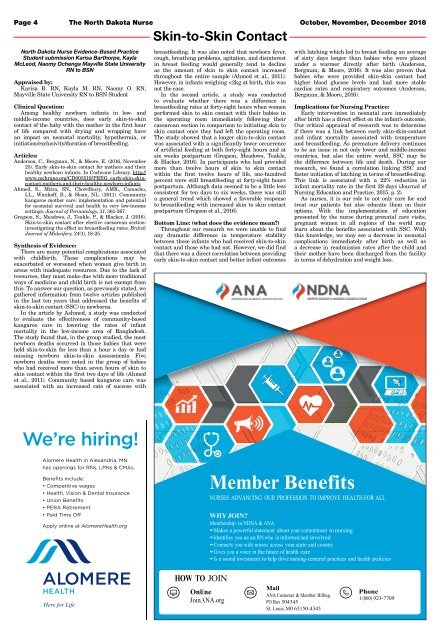The North Dakota Nurse - October 2018
Create successful ePaper yourself
Turn your PDF publications into a flip-book with our unique Google optimized e-Paper software.
Page 4 <strong>The</strong> <strong>North</strong> <strong>Dakota</strong> <strong>Nurse</strong> <strong>October</strong>, November, December <strong>2018</strong><br />
Skin-to-Skin Contact<br />
<strong>North</strong> <strong>Dakota</strong> <strong>Nurse</strong> Evidence-Based Practice<br />
Student submission Karisa Barthorpe, Kayla<br />
McLeod, Naomy Ochenga Mayville State University<br />
RN to BSN<br />
Appraised by:<br />
Karisa B. RN, Kayla M. RN, Naomy O. RN,<br />
Mayville State University RN to BSN Student<br />
Clinical Question:<br />
Among healthy newborn infants in low- and<br />
middle-income countries, does early skin-to-skin<br />
contact of the baby with the mother in the first hour<br />
of life compared with drying and wrapping have<br />
an impact on neonatal mortality, hypothermia, or<br />
initiation/exclusivity/duration of breastfeeding.<br />
Articles:<br />
Anderson, C., Bergman, N., & Moore, E. (2016, November<br />
25). Early skin-to-skin contact for mothers and their<br />
healthy newborn infants. In Cochrane Library. http://<br />
www.cochrane.org/CD003519/PREG_early-skin-skincontact-mothers-and-their-healthy-newborn-infants<br />
Ahmed, S., Mitra, SN., Chowdhury, AMR., Camacho,<br />
LL., Winikoff, B., & Sloan, NL. (2011). Community<br />
kangaroo mother care: implementation and potential<br />
for neonatal survival and health in very low-income<br />
settings. Journal of Perinatology, 31, 361-367.<br />
Gregson, S., Meadows, J., Teakle, P., & Blacker, J. (2016).<br />
Skin-to-skin contact after elective caesarean section:<br />
investigating the effect on breastfeeding rates. British<br />
Journal of Midwifery, 24(1), 18-25.<br />
Synthesis of Evidence:<br />
<strong>The</strong>re are many potential complications associated<br />
with childbirth. <strong>The</strong>se complications may be<br />
exacerbated or worsened when women give birth in<br />
areas with inadequate resources. Due to the lack of<br />
resources, they must make due with more traditional<br />
ways of medicine and child birth is not exempt from<br />
this. To answer our question, as previously stated, we<br />
gathered information from twelve articles published<br />
in the last ten years that addressed the benefits of<br />
skin-to-skin contact (SSC) in newborns.<br />
In the article by Ashmed, a study was conducted<br />
to evaluate the effectiveness of community-based<br />
kangaroo care in lowering the rates of infant<br />
mortality in the low-income area of Bangladesh.<br />
<strong>The</strong> study found that, in the group studied, the most<br />
newborn deaths occurred in those babies that were<br />
held skin-to-skin for less than a hour a day or had<br />
missing newborn skin-to-skin assessments. Five<br />
newborn deaths were noted in the group of babies<br />
who had received more than seven hours of skin to<br />
skin contact within the first two days of life (Ahmed<br />
et al., 2011). Community based kangaroo care was<br />
associated with an increased rate of success with<br />
breastfeeding. It was also noted that newborn fever,<br />
cough, breathing problems, agitation, and disinterest<br />
in breast feeding would generally tend to decline<br />
as the amount of skin to skin contact increased<br />
throughout the entire sample (Ahmed et al., 2011).<br />
However, in infants weighing

















